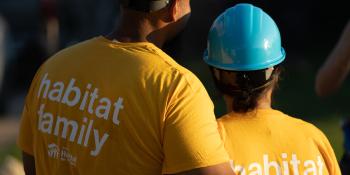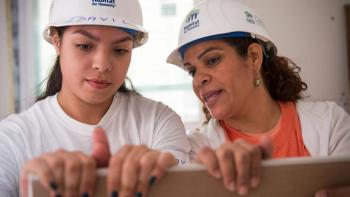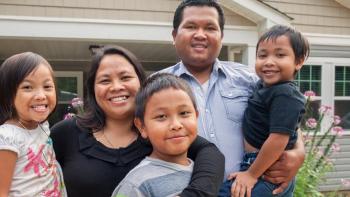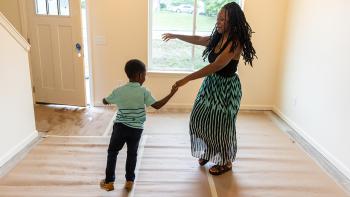Habitat walks lockstep with each family as they invest hard work during their path to homeownership. From attending homeowner courses to helping to build their own homes of the homes of others, each step empowers future homeowners and helps foster the skills they need to succeed.
We manage the homeowner selection process at the local level, from initial inquiry to closing.
Interested in learning how to become a Habitat homeowner? Follow along below!
Jump to:
Step 1: Inquire | Step 2: Apply | Step 3: Interview | Step 4: Approve | Step 5: Participate | Step 6: Close | Step 7: Move in
Step 1: Inquire
Local Habitat affiliates host information sessions where potential homeowners can learn about their homeownership program. This gives potential future homeowners time to ask questions and make connections.
“At the orientation, I heard everything from how to apply to how the process works,” says Maximino, an Evergreen Habitat homeowner. “They explained everything to us and answered all our questions.”
Reach out to your local Habitat to learn about in-person or online sessions.
To help non-English speakers achieve their dream of homeownership, affiliates can arrange a translator during the homebuying process
Step 2: Apply
If a family feels Habitat’s homeownership program is the right fit for them, they apply locally during an open enrollment period.
Habitat staff work with applicants as they submit paperwork such as pay stubs or other proof of income, documentation of substandard housing, and more.
Local Habitat staff review each application carefully while focusing on the following main criteria:
- Need for housing: Prospective homebuyers must demonstrate a need for safe, affordable housing.
- Willingness to partner: Once selected, homebuyers must partner with Habitat through the process.
- Ability to pay an affordable mortgage: Homebuyers must also be able and willing to pay an affordable mortgage. Habitat mortgage payments are cycled back into the community to help build additional Habitat houses.
Read more about our homeowner qualifications.
Step 3: Interview
The next step is an in-person interview.
Habitat staff and/or volunteers make a home visit to hear more about a potential future homeowner’s desire to partner with Habitat, get to know the family, and learn about their current housing status and future housing needs
Step 4: Approve
Local Habitat staff and volunteers carefully review each family’s application packet and present their recommendations to the local board of directors.
At most local Habitats, the board makes the final determination.
Step 5: Participate
Once selected, a family is officially on their way to becoming a homeowner.
Early in the process, Habitat provides a mix of hands-on and classroom learning through homebuyer education classes. From budgeting to small home repairs, landscaping to retirement planning, each course is aimed to help homeowners achieve success in their new homes, all while developing connections with their fellow future Habitat homeowners.
Each family who partners with Habitat completes a certain number of hours of sweat equity before move-in day. Often, any adult member of the immediate or extended family – and sometimes volunteers, co-workers or friends – can contribute sweat equity hours.
Participants can accrue hours in a variety of ways, including working on a Habitat build site (their own or someone else’s), helping out in the Habitat ReStore, and assisting with administrative tasks in the Habitat office.
Many Habitat affiliates also offer creative solutions so that children can be a part of the process by accruing sweat equity hours. For example, Chipola Area Habitat in Florida awards one hour of sweat equity for every “A” that a child earns in school.
Step 6: Close
Next, homebuyers complete the paperwork for a mortgage. Habitat offers homebuyers an affordable mortgage with monthly payments compatible with their household income. Mortgage payments made by Habitat homeowners help build more affordable homes.
Step 7: Move in
Once all of the forms are signed and all of the construction is complete, it’s time to celebrate!
Friends and family, as well as the Habitat staff and volunteers who worked alongside the family on this journey, come together to dedicate the home. It’s the first of many joyous occasions to be celebrated in the new home.
Now, with the stability of a home they helped build, families have more time and resources to invest in other areas of their lives. They can invest more in their family’s health and education. Many Habitat homeowners go on to pursue secondary degrees and hit career goals. Others find ways to continue to give back to the community that welcomed them home.
Whatever a family’s long-held dreams are, affordable homeownership frees them from many of the barriers – stress, financial instability and more – that stand in their way.




